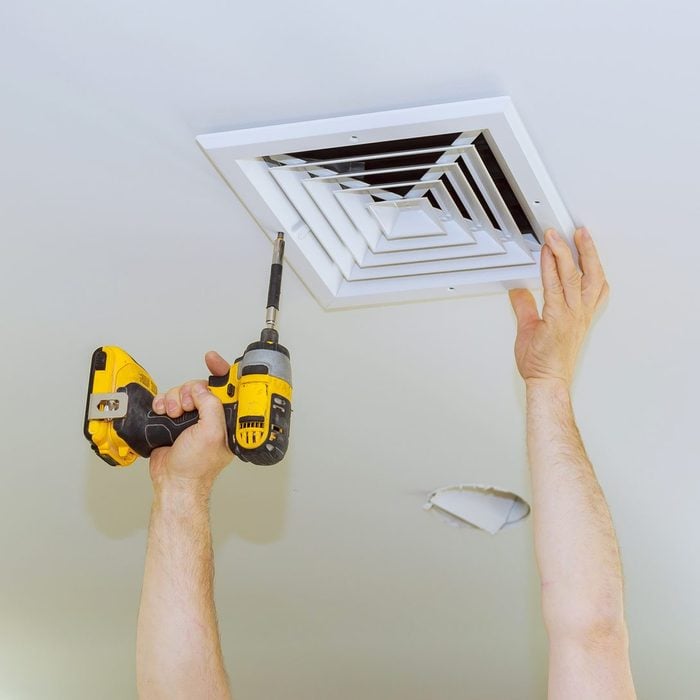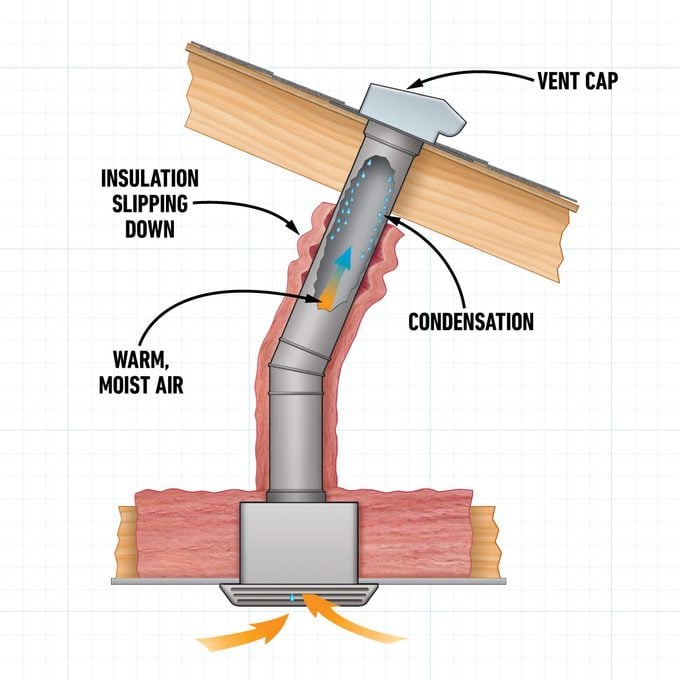Why Is Water Dripping from My Bathroom Fan?
Updated: Feb. 27, 2024

Drips are usually caused by condensation, but a roof leak can also be the culprit. Here's how to stop that dripping for good.
If you see water stains in the drywall around your bathroom exhaust fan, or water dripping from the fan itself, the most likely issue is condensation in the fan duct.
Of course, there’s always the possibility of a roof leak.
“I had a customer call just yesterday and explain that their can light in the ceiling was filling up with water after it rained recently,” says Korey Gregory of ASAP Restoration. “Oddly enough this happens quite commonly.
“One of the reasons is because the light fixtures, fans, vents and skylights are almost always at the lowest point. If a property has a leak in the roof or if elevated appliances such as HVAC units start to leak, gravity does the rest of the work and brings the water pooling into these spots.”
I’ve seen this in my own bathroom. After a heavy rain, a mysterious pool of water collected in the middle of the floor. I couldn’t figure out the source until I saw water dripping from the bottom of a light fixture dome. I guess that means our next project is to repair the leak.
Gregory is among the experts I asked to explain what causes these water issues, and how to deal with them.
On This Page
About the Experts
Drew Mansur, a self-described “serial renovator,” co-founded TileCloud, Australia’s leading online tile outlet. He has a degree in construction management.
Korey Gregory is the superintendent for ASAP Restoration, LLC, based in Phoenix, Arizona. He’s a licensed contractor with more than 17 years experience.
Joseph Wade is vice president of operations for Benjamin Franklin Plumbing.
What Causes Water Dripping From Bathroom Fan?

Our experts cite five reasons:
- Condensation: This is the most common reason. When warm, moist air from your shower meets the cooler air in the ductwork of your fan, condensation forms. This water accumulates and eventually drips back down through the fan. Properly installed ducts are usually sloped back to the fan to allow water to drip out rather than collecting and pooling inside.
- Underused fan: If the duct is properly insulated, the drip problem may be because you aren’t using your fan often enough. Some warm air will still escape into the ducting whether the fans runs or not. On really cold days, that warm air will condense inside the ducting, especially if you never run the fan to dry it out.
- Blocked or inadequate venting: The vent leading outside may be blocked or the wrong size. This can cause the moist air to back up and condense within the duct or fan housing.
- Plumbing or roof leaks: If you have water pipes in the attic, one may have sprung a leak, spraying water onto the duct or the fan itself.
- Improper installation: “If your fan is not installed correctly,” says Wade, “water can accumulate and possibly lead to dripping.” This would include using the wrong size ducts, failing to insulate them, or simply putting the fan in the wrong place. “If your bathroom fan is directly over your shower or tub, and you are experiencing excessive leakage from your fan, you might want to move it,” Wade says.
How To Fix a Dripping Bathroom Vent
Tools and materials
- Stepladder;
- Duct insulation;
- Zip ties or aluminum tape;
- Roof repair supplies.
- Inspect the fan and the vent opening: Get on a stepladder, remove the fan cover and look at your damper flap just behind the fan. It channels airflow and prevents water from moving upward into your ducts. If it doesn’t spin readily when your push in it, it may need to be replaced. The vent cover on your roof could also be the issue. It could have suffered weather-related damage that prevents it from expelling air and keeping water out. Replace it, if necessary.
- Update the insulation: Head into the attic and check the insulation on the ducts. You may find it simply needs to be refastened. If you see your duct isn’t insulated at all, pick up duct insulation at the home center. Use zip ties or aluminum tape to fasten the insulation.
- Fix the roof: If you suspect a roof leak, determine where the water is coming from. “Typically, there’s a small leak under a roofing tile or the like,” Gregory says. “But frequently water can also come from the air conditioner unit drip line. Plug the leak, fix the roof and then address the water damage and potential mold issues that come with soaked drywall.”
How much does it cost to fix a leaking bathroom fan?
That depends on what’s wrong.
- If you need to replace the damper, it will cost about $15 for the part, plus $150 an hour for labor if you have to call a pro to retrofit it. Expect to pay about the same to replace a damaged roof vent.
- If the situation calls for more duct insulation, it’s DIY-able. You can buy a 15-foot roll for less than $20, and a roll of aluminum tape for about $20.
How To Prevent a Bathroom Exhaust Fan From Dripping Water
Install a condensation trap
“If you can’t change the amount of moisture in the bathroom,” says Mansur, “you can at least stop it from dripping down. Install a condensation trap or a drip loop in the ductwork to catch condensation before it drips down.”
Lubricate the damper
Spray a little WD-40 on the damper mechanism whenever you clean the fan. Do this every six to 12 months, depending on how often you use the fan.
Maintain the insulation
Check the insulation on the ductwork periodically and replace any that fell off or degraded.
Upgrade your bathroom fan
If your bathroom fan is old or not powerful enough for the size of your bathroom, upgrade to a more efficient model.
“Bathroom fans should be replaced every five to 10 years, as older ventilation fans are less effective at moving moisture out of the bathroom,” Wade says. Mansur adds you can even get some with built-in humidity sensors that automatically turn on when moisture levels are high.
